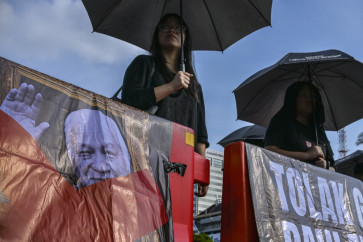Popular Reads
Top Results
Can't find what you're looking for?
View all search resultsPopular Reads
Top Results
Can't find what you're looking for?
View all search resultsSRI rice cultivation yields significant results in NTT
The Indonesia Climate Change Trust Fund (ICCTF) and Yogyakarta-based Gadjah Mada University’s (UGM) School of Agriculture have joined hands to develop and implement a rice intensification (SRI) method to grow paddy in Kupang regency, East Nusa Tenggara’s (NTT)
Change text size
Gift Premium Articles
to Anyone
T
he Indonesia Climate Change Trust Fund (ICCTF) and Yogyakarta-based Gadjah Mada University’s (UGM) School of Agriculture have joined hands to develop and implement a rice intensification (SRI) method to grow paddy in Kupang regency, East Nusa Tenggara’s (NTT).
The project started in April 2016 as part of ICCTF’s climate adaptation strategy, and the SRI method has already been implemented in Tarus and Baumata subdistricts, both of which continue to face limited water supply that hinders irrigation.
A significant increase in rice production was found in Tarus, from 5.6 tons per hectares using the conventional method, to 12 tons per hectare under the SRI project.
In Baumata, meanwhile, production rose by 3 tons of rice per ha from 5.6 tons.
“The SRI seedlings have yielded a more productive harvest; up to 100 percent higher than regular rice seedlings. They also need less water to grow,” Murtiningrum, secretary of UGM’s department of bio system and agricultural engineering, said during an SRI rice harvest fair in Tarus last Saturday.
“The method is an answer to the challenges farmers are currently facing, particularly those living in dry areas,” he added.
ICCTF executive director Tonny Wagey said the SRI method was an innovative and sustainable way of cultivating rice that resulted in high productivity by using 7-day-old seedlings, greater plant spacing, organic fertilizer and more efficient irrigation.
In comparison, the conventional method involves 25-day-old seedlings with narrow plant spacing, chemical fertilizer and more water.
Citing data from the Central Statistics Agency (BPS), Tonny said that rice production in NTT stood only at 3.56 tons per ha, or about 67 percent below the national figure of 5.34 tons per ha in 2015. NTT also produces less rice than neighboring West Nusa Tenggara (NTB), with 5.17 tons per ha.
Farmers are among the groups that are most vulnerable to climate change, which can increase poverty in agricultural areas, said Rohmad Supriadi from the National Development Planning Agency (Bappenas), who also attended the event in Tarus.
“Farmers really need to adapt to climate change, particularly [as it brings immediate] changes in rainfall intensity, temperature and water supply, which affects planting times, the choice of plant variants and cropping patterns,” he added.
Yanes Sain, a farmer from Tarus, said he initially doubted the SRI method because it used less seedlings than the conventional method he was used to.
But after using the method, his harvest yielded twice the amount of rice in the latest harvest season.
“It would be good if the program was adopted by other farmers across Kupang regency to improve their livelihoods,” he said.
NTT Governor Frans Lebu Raya echoed Yanes’s sentiments and express his hope that the method could be implemented the province’s 22 regencies.
“We have seen the success stories in Tarus and Baumata,” he pointed out.
After it was initiated in NTT as a pilot project, the method was implemented in Central Java and Yogyakarta.










